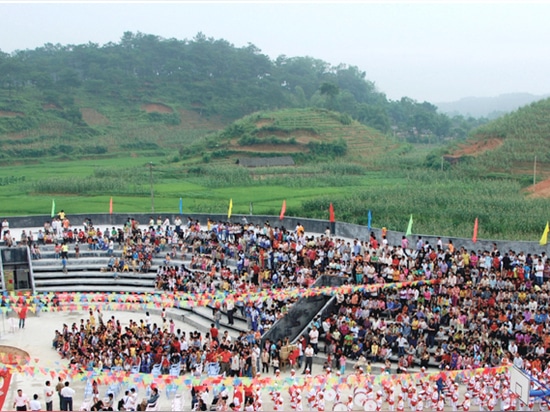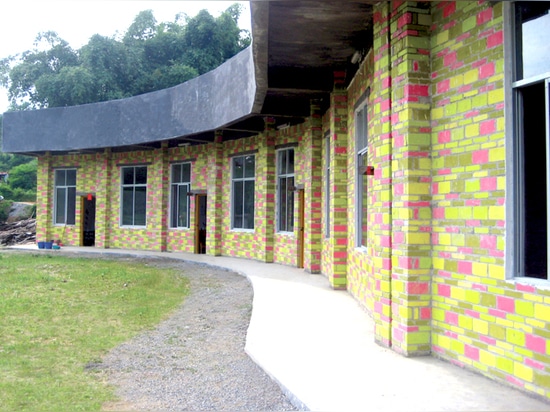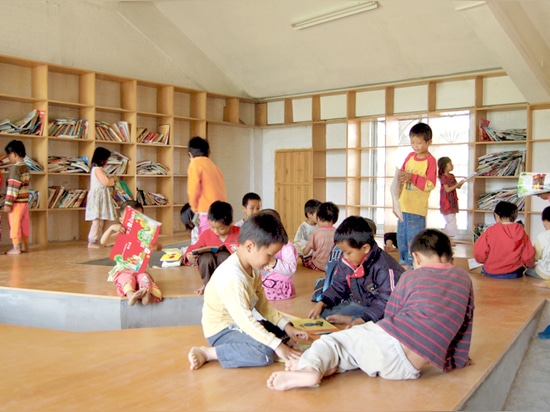
#PUBLIC ARCHITECTURE PROJECTS
Rural Education
The Guangdong Province in South China is considered one of the rich provinces in the country. However, like in all other regions, the economic growth is based in the urban centres along the coast
From the hinterland the unskilled labour force moved already 30 years ago to the coastal regions and send back a part of their income to keep the family, consisting of the elderly and the children, going. This relationship between urban and rural life causes many social and economic problems. The young and clever leave as soon as they can, to take jobs in the bustling new towns. Farming becomes more and more a secondary activity and the villagers depend on the income of their migrated parents, children or relatives. Such an development is not at all sustainable and increases the difference between countryside and city.
Qinmo Village in the Northwest of Guangdong Province, with about 1,800 villagers, is based on growing rice, keeping pigs and chickens. The income of the migrant workers is invested in bigger houses and decoration. With a project by John Lin and Joshua Balchover the education of the local community in many aspects is aided to shift towards economic self-sufficiency.
The two architects run the firm rufwork (rural urban framework), who takes care of such projects between self-help and strategic conceptions for needed infrastructure. The strategy in Qinmo is supported by a network of stakeholders, like the University of Hong Kong, Green Hope Foundation, Chinese Culture Promotion Society, Luk Him Sau Charitable Trust and others, including the local government bureaus of education and construction.
The new school building was designed by John Lin and takes the form of a terraced landscape, which forms a public space. This public space is used for communal festivities and sports events. The seating is constructed to allow ventilation for the classrooms below.
The building was constructed with the cheapest material available, concrete beams and columns with brick infill. The villagers painted the bricks with bright blazing colours and constructed the building in self-help
The library in the building is designed as a landscape of cut out islands within the raised floor, forming void areas for sitting and reading. The roof carries a series of community gardens, for which the kids below have to care and were they learn new aspects of gardening. The playground in front of the terrace, with a basketball field, connects directly to the village.
The new primary school left the old school building vacant and without use. The Hong Kong based charity organisation of Lucy Tsai commissioned John Lin and Joshua Bolchover to work with the agricultural organisation Kadoorie Farm and Botanic Garden, on the re-use of the building. It became a teaching eco-household and education centre for agricultural techniques.
With a greenhouse and kitchen garden as well as experiments with economically profitable products – premium chicken and tea-tree oil – the villagers learn how to live from their land within an changing economy and a improving market for quality products. Again, very little money was available for the renovation. A concrete screen with two patterns was locally produced and used for the gallery in the courtyard. The old school became the new informal community centre, where charity organisations from Hong Kong organize education camps for children.
With little means, goodwill and the enthusiasm on all sides, the village schools in Qinmao became new focal points in the life of the citizens. With self-confidence and new pride the village can show that development is no longer depending only on money, but also on knowledge. Such projects will not change the development on a big scale, but they put a new aspect on the village life, to keep up with the challenge of economic dependence.
Conceptually, the two schools create new public platforms for experiment and discussion – what can be achieved more with architecture. The integration of the villagers in the building process and continuing support with workshops, gives hope that new things are possible, also in the rural hinterland.





